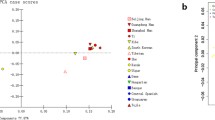Abstract
The Duffy blood group system consists of three alleles, FYA, FYB, and FY. To study the molecular evolution of the three alleles, we established the polymorphism of a dinucleotide (GT) repeat sequence (designated FyGT/ C) in the 3′ flanking region of the Duffy gene, and studied the relationship between FyGT/C and Duffy polymorphism in Japanese, people of African origin, and chimpanzee. By single-strand conformation polymorphism and sequence analysis, five and two alleles were identified in Japanese and Africans, respectively. In 110 random Japanese, the FyGT/C genotypes observed were in agreement with Hardy-Weinberg law. From the sequence of the chimpanzee Duffy gene, including both flanking regions, FYB was identified as the ancestral gene of the human alleles. The FyGT/C sequences associated with the FY allele of Africans were distinct from those of Duffy positives, whereas the FYB and FYA alleles shared common FyGT/C sequences. Thus, it is suggested that the first split took place between the FYB and FY alleles, and the second between the FYB and FYA alleles.
Similar content being viewed by others
Author information
Authors and Affiliations
Additional information
Received: 25 July 1996 / Revised: 10 October 1996
Rights and permissions
About this article
Cite this article
Li, J., Iwamoto, S., Sugimoto, N. et al. Dinucleotide repeat in the 3′ flanking region provides a clue to the molecular evolution of the Duffy gene. Hum Genet 99, 573–577 (1997). https://doi.org/10.1007/s004390050408
Issue Date:
DOI: https://doi.org/10.1007/s004390050408




